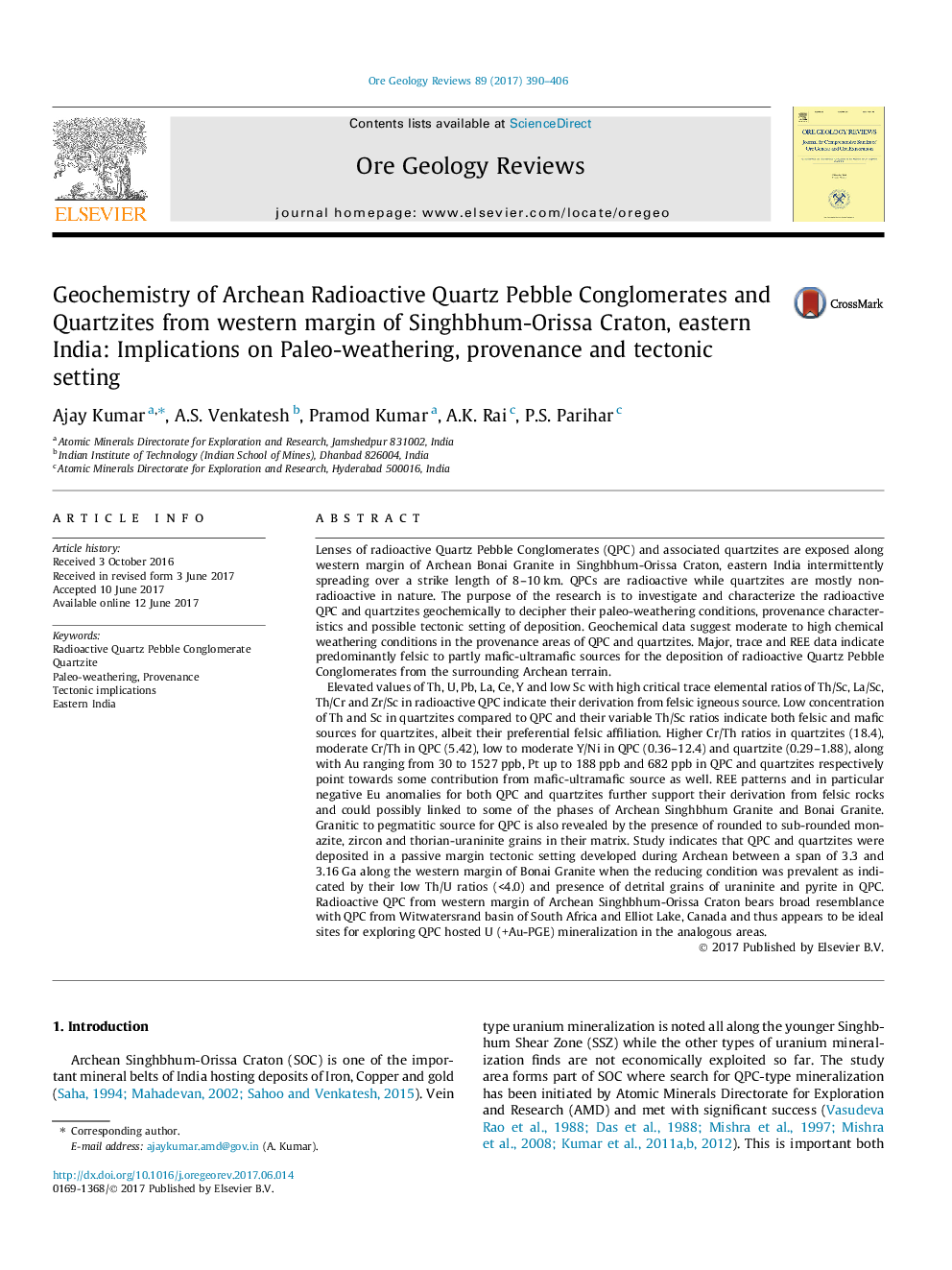| کد مقاله | کد نشریه | سال انتشار | مقاله انگلیسی | نسخه تمام متن |
|---|---|---|---|---|
| 5782248 | 1637218 | 2017 | 17 صفحه PDF | دانلود رایگان |

- Radioactive QPC occur in the western margin of Archean Singhbhum-Orissa Craton, eastern India.
- QPC and quartzites exhibit moderate to high paleo-weathering conditions in the provenance.
- They were derived predominantly from felsic with minor mafic- ultramafic mixed source.
- QPC-quartzite sequence developed in a passive margin tectonic setting during 3.3 to 2.8Â Ga.
- Eastern Indian radioactive QPC bear resemblance to world class U +REE+Au bearing Mesoarchean QPC.
Lenses of radioactive Quartz Pebble Conglomerates (QPC) and associated quartzites are exposed along western margin of Archean Bonai Granite in Singhbhum-Orissa Craton, eastern India intermittently spreading over a strike length of 8-10Â km. QPCs are radioactive while quartzites are mostly non-radioactive in nature. The purpose of the research is to investigate and characterize the radioactive QPC and quartzites geochemically to decipher their paleo-weathering conditions, provenance characteristics and possible tectonic setting of deposition. Geochemical data suggest moderate to high chemical weathering conditions in the provenance areas of QPC and quartzites. Major, trace and REE data indicate predominantly felsic to partly mafic-ultramafic sources for the deposition of radioactive Quartz Pebble Conglomerates from the surrounding Archean terrain.Elevated values of Th, U, Pb, La, Ce, Y and low Sc with high critical trace elemental ratios of Th/Sc, La/Sc, Th/Cr and Zr/Sc in radioactive QPC indicate their derivation from felsic igneous source. Low concentration of Th and Sc in quartzites compared to QPC and their variable Th/Sc ratios indicate both felsic and mafic sources for quartzites, albeit their preferential felsic affiliation. Higher Cr/Th ratios in quartzites (18.4), moderate Cr/Th in QPC (5.42), low to moderate Y/Ni in QPC (0.36-12.4) and quartzite (0.29-1.88), along with Au ranging from 30 to 1527Â ppb, Pt up to 188Â ppb and 682Â ppb in QPC and quartzites respectively point towards some contribution from mafic-ultramafic source as well. REE patterns and in particular negative Eu anomalies for both QPC and quartzites further support their derivation from felsic rocks and could possibly linked to some of the phases of Archean Singhbhum Granite and Bonai Granite. Granitic to pegmatitic source for QPC is also revealed by the presence of rounded to sub-rounded monazite, zircon and thorian-uraninite grains in their matrix. Study indicates that QPC and quartzites were deposited in a passive margin tectonic setting developed during Archean between a span of 3.3 and 3.16Â Ga along the western margin of Bonai Granite when the reducing condition was prevalent as indicated by their low Th/U ratios (<4.0) and presence of detrital grains of uraninite and pyrite in QPC. Radioactive QPC from western margin of Archean Singhbhum-Orissa Craton bears broad resemblance with QPC from Witwatersrand basin of South Africa and Elliot Lake, Canada and thus appears to be ideal sites for exploring QPC hosted U (+Au-PGE) mineralization in the analogous areas.
Archean radioactive (+Au+PGE) Quartz Pebble Conglomerate (QPC) from Singhbhum-Orissa Craton, eastern India.334
Journal: Ore Geology Reviews - Volume 89, October 2017, Pages 390-406